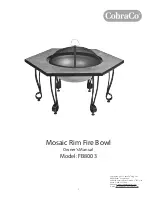
22
2.7
Maintenance
The water heater must be checked and cleaned
regularly (at least once a year) by an accredited installer,
so that proper operation is guaranteed. The bar burners,
control and safety valves must also be checked. (see
figure 17).
2.8
Anode
The life of the anode is determined by the quality and
the quantity of water flowing through the water heater.
Therefore, we recommend that the anode is checked
regularly - preferably simultaneously with an internal
inspection of the enamelled tank. In order to determine
the frequency with which the anodes must be replaced,
the water side of the boiler must be checked three
months after installation. The anodes must be replaced
if more than 50% has dissolved at any point on their
length.
Procedure:
1. Shut off the cold water supply tap.
2. Completely empty the water heater by means of the
draw-off tap. Remember to ventilate the water heater.
3. Remove the sealing plates at the hand holes on the
outer cover of the water heater.
4. Open the hand holes and inspect the anodes. In
order to guarantee a water-tight seal at the hand
holes, the rubber O-rings must be replaced (see
figure 18).
If the anodes need replacing:
1. Disassemble the concentric flue tube.
2. Disassemble the electrical connection of the
ventilation fan on the top-box.
3. Loosen the fastening bolts of the top-box.
4. Remove the top-box, the positioning of the anodes
will now become visible (see figure 18).
5. Loosen the anodes with suitable tools and replace
with new ones. NOTE: the anodes must be in contact
with the tank (metal on metal). For if the anodes and
tank are electrically separated (as a result of the
sealant used), the anode cannot perform its function.
This can shorten the life-span of the tank.
6. Assemble everything in reverse order.
7. Fill the water heater.
2.9
Descale procedure
Calcium deposition depends on the type of water
and the demand. In addition, calcium deposition
increases at high water temperatures. A temperature
setting of 60°C is recommended, which will keep
calcium deposition to a minimum.
Inspection hatches are located on the right and left
sides for inspecting and deliming the tank. The hand
holes can be reached via the covering plates on the
outer jacket.
Empty the water heater before opening the
inspection hatches. Deliming must be executed with the
correct tools. Consult the supplier of the water heater or
the installer on this matter. In order to guarantee a
water-tight seal of the hand holes, the rubber O-rings in
the hand holes must be replaced (see figure 17).
Figure 18 - Maintenance anodes
Figure 17











































